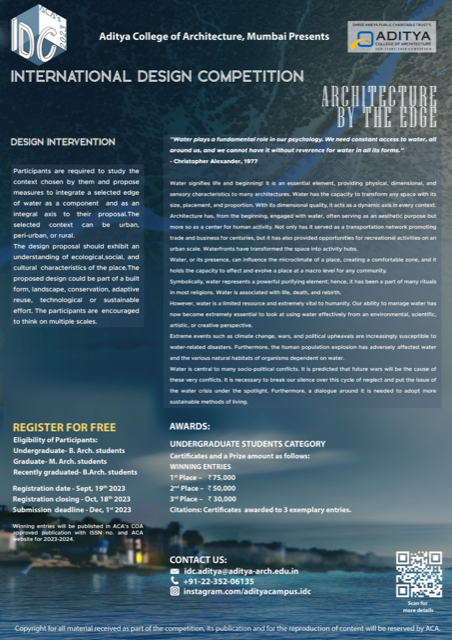- HOME
- /
- ARCHITECTURE BY THE EDGE
“Water plays a fundamental role in our psychology. We need constant access to water, all around us, and we cannot have it without reverence for water in all its forms.” Christopher Alexander, 1977
Water signifies life and beginning! It is an essential element, providing physical, dimensional, and sensory characteristics to many architectures. Water has the capacity to transform any space with its size, placement, and proportion. With its dimensional quality, it acts as a dynamic axis in every context.
Architecture has, from the beginning, engaged with water, often serving as an aesthetic purpose but more so as a center for human activity. Not only has it served as a transportation network promoting trade and business for centuries, but it has also provided opportunities for recreational activities on an urban scale. Waterfronts have transformed the space into activity hubs. Water, or its presence, can influence the microclimate of a place, creating a comfortable zone, and it holds the capacity to affect and evolve a place at a macro level for any community.
Symbolically, water represents a powerful purifying element; hence, it has been a part of many rituals in most religions. Water is associated with life, death, and rebirth.
However, water is a limited resource and extremely vital to humanity. Our ability to manage water has now become extremely essential to look at using water effectively from an environmental, scientific, artistic, or creative perspective. Extreme events such as climate change, wars, and political upheavals are increasingly susceptible to water-related disasters. Furthermore, the human population explosion has adversely affected water and the various natural habitats of organisms dependent on water.
Water is central to many socio-political conflicts. It is predicted that future wars will be the cause of these very conflicts. It is necessary to break our silence over this cycle of neglect and put the issue of the water crisis under the spotlight. Furthermore, a dialogue around it is needed to adopt more sustainable methods of living.
With this insight, we bring forth the 10th IDC conference with the theme as ‘WATER,’ with the aim to bring into poignant concern water as a perishable resource and the need to bring back sanctity synonymous with the use of water in Architecture.
Water acts as a connector between the physical and the metaphysical. It serves as a reminder of our connection with our ancestors while also serving as a bridge to connect us with the future. Given the current water crisis we find ourselves in, we invite students to produce designs that further this idea of water and its connection with the built environment.
OBJECTIVES OF COMPETITION
To bring to the forefront the symbiotic relationship we humans share with water
Bring out qualities of water such as tranquillity, fluidity, sensory and its sense of vastness through design
Reflecting on how our ancestors shared their relationship with water and how that can be revitalised to suit today’s context
To keep focus on rising water crisis how can we as architects use water responsibly and wisely
Leveraging modern technology into constructing with water
From a historical perspective water always associated with architecture – revitalising water storage facilities and its association with existing urban fabric
Water and climate change – Coastal degradation
Scope – Area of interest and innovation (any attempt done related to water at any scale) Expected Outcomes based on given requirements Competition Brief
The competition is open to architecture students. Participants are required to study the context chosen by them and propose measures to integrate a selected edge of water as a component and as an integral axis to their proposal. The selected context can be urban, peri-urban, or rural. The design proposal should exhibit an understanding of ecological, social, and cultural characteristics of the place. The proposed design could be part of a built form, landscape to conservation, adaptive reuse, technological or sustainable effort. The participants are encouraged to think on multiple scales.
Eligibility of Participants:
Undergraduate- B. Arch. students
Graduate- M. Arch. students
Recently graduated- B.Arch. students

